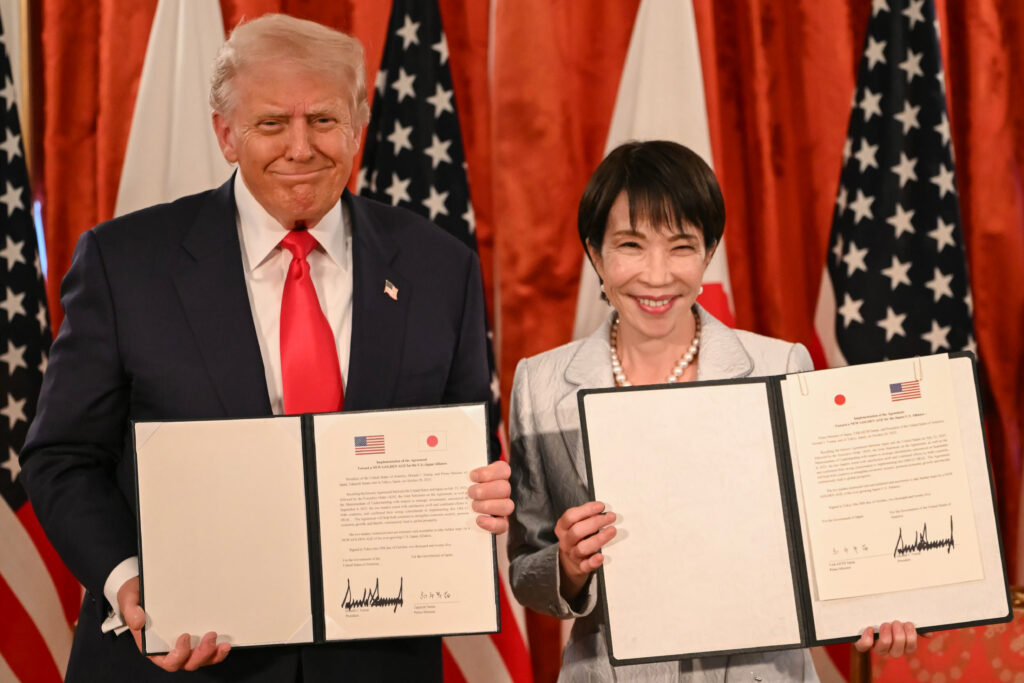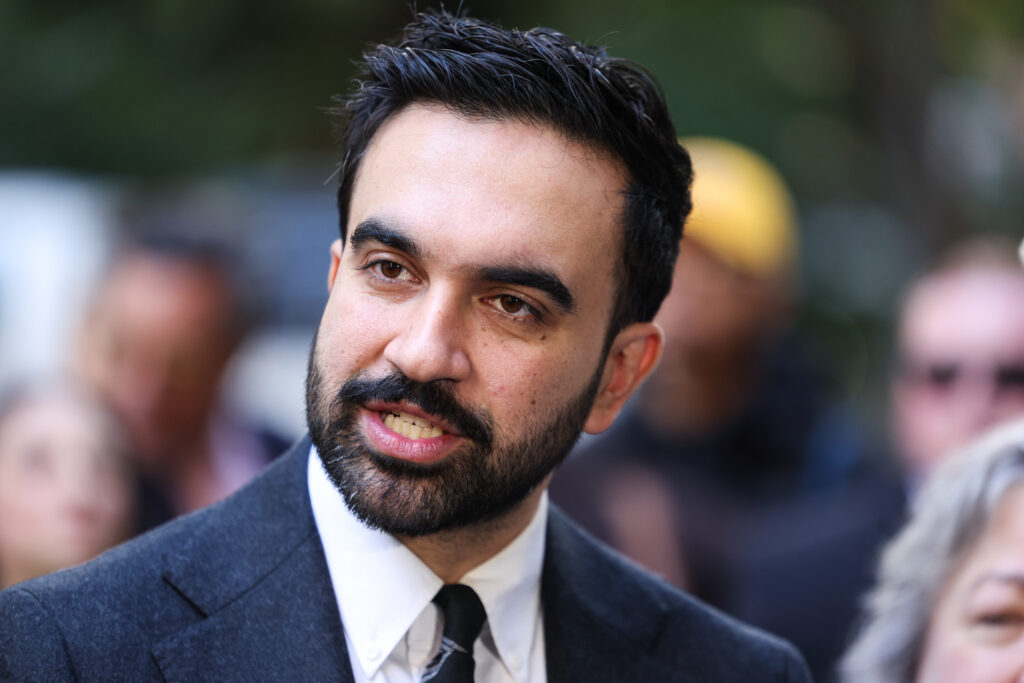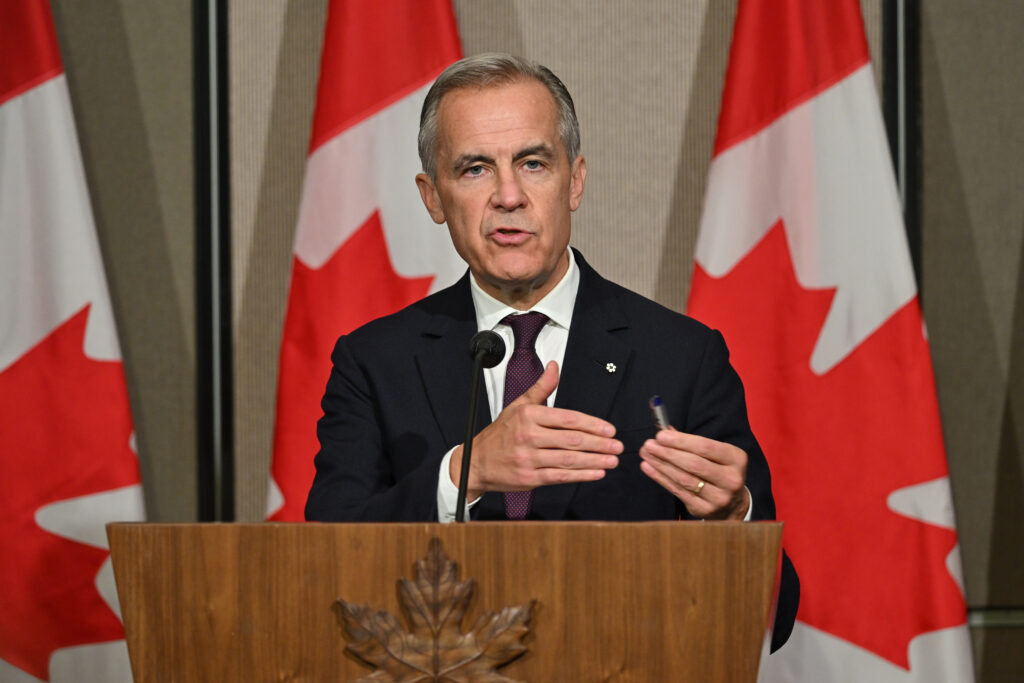Vers un “nouvel âge d’or”: à Tokyo, Trump conquis par la nouvelle Première ministre Takaichi
Promesse d’un “nouvel âge d’or”, accord sur les terres rares et échanges très chaleureux: la Première ministre japonaise Sanae Takaichi a soigné mardi sa première rencontre avec Donald Trump, lequel l’a assurée que Washington était le plus solide des alliés de Tokyo.Le Japon est la deuxième étape de la tournée du président américain en Asie, après la Malaisie et avant la Corée du Sud, où aura lieu jeudi sa rencontre la plus attendue du voyage, avec son homologue chinois Xi Jinping, censée sceller un compromis commercial entre les deux puissances.Un test diplomatique à forts enjeux pour Sanae Takaichi, première femme à gouverner le Japon.En poste depuis seulement une semaine, elle dispose d’un atout dans son jeu: sa proximité avec l’ancien Premier ministre japonais Shinzo Abe, son mentor, assassiné en 2022… et dont Donald Trump lui-même était devenu proche pendant son premier mandat. La dirigeante japonaise a remercié mardi Donald Trump pour son “amitié durable” avec Shinzo Abe. “J’ai été très impressionnée et inspirée par vous”, a-t-elle aussi lancé à M. Trump.Mme Takaichi a également indiqué vouloir ouvrir “un nouvel âge d’or” des relations nippo-américaines, alors que Tokyo fait face à la montée en puissance militaire de son voisin chinois — et qu’il subit les surtaxes douanières de Washington.”Je tiens à vous assurer que ce sera une relation privilégiée. Sachez que (…) si vous avez besoin de quoi que ce soit, si je peux aider, nous serons là. Nous sommes un allié au plus haut niveau”, l’a rassuré M. Trump en début d’entretien.Selon une déclaration des deux dirigeants, Tokyo et Washington “feront de nouveaux pas vers un nouvel âge d’or” de leur alliance “toujours plus grande”.Selon la Maison Blanche, Mme Takaichi a par ailleurs indiqué son intention de recommander le dirigeant américain pour le prix Nobel de la Paix –devenu une obsession pour M. Trump.- Dépenses militaires -Signe de proximité, les deux pays ont signé mardi un accord-cadre pour “sécuriser” leurs approvisionnements de terres rares et minéraux critiques, via une étroite coopération et des soutiens financiers.Et ce peu après que Pékin a adopté des restrictions drastiques sur ses exportations de ces matériaux essentiels pour les industries de pointe et sur lesquels la Chine exerce un quasi-monopole.En matière de défense, M. Trump, adepte du donnant-donnant, exige que les alliés des Etats-Unis musclent leurs dépenses militaires pour continuer à bénéficier de la protection américaine –et en particulier le Japon, où quelque 60.000 militaires américains sont stationnés.M. Trump rendra d’ailleurs visite mardi à certains à bord du porte-avions USS George Washington, au large de Tokyo.Soucieuse de ménager Washington, Sanae Takaichi avait annoncé vendredi que le Japon porterait à 2% du PIB son budget de défense dès l’exercice fiscal actuel, avec deux ans d’avance.Egalement pour mettre le milliardaire de 79 ans dans les meilleures dispositions, son hôte lui a offert des clubs de golf ayant appartenu à Shinzo Abe et des balles de golf plaquées or.Tokyo pourrait aussi dévoiler l’achat d’une centaine de pick-up Ford F-150, dans un geste de bonne volonté commerciale.Pour sa part, Donald Trump a rencontré mardi des familles de Japonais enlevés par la Corée du Nord, un sujet extrêmement sensible dans l’archipel.- Automobile -Le commerce domine également cette rencontre.Le Japon et les Etats-Unis ont déjà trouvé cet été un compromis commercial, mais certains points restent en suspens.Washington a abaissé mi-septembre à 15% les droits de douane totaux sur les automobiles japonaises, jugés encore trop élevés par les constructeurs. Le secteur est crucial pour les exportations et l’économie nippones. Autre sujet de discussion: la forme que prendront les 550 milliards de dollars d’investissements nippons sur le sol américain, prévus dans l’accord conclu en juillet. A rebours de propos de M. Trump, Tokyo avait estimé que seuls 1 à 2% du montant seraient des investissements directs réels, le reste étant constitué de prêts et garanties de prêts.Selon la télévision NHK, Tokyo et Washington devaient aussi signer un protocole d’accord sur la construction navale, secteur où les Etats-Unis entendent rattraper leur retard.Après Tokyo, Donald Trump se rend mercredi en Corée du Sud, où il rencontrera jeudi Xi Jinping, en marge d’un sommet des pays de l’Asie Pacifique (Apec). Un entretien où est attendue la conclusion d’une trêve dans la guerre commerciale que se livrent Pékin et Washington à coups de droits de douane et de restrictions diverses.
Is New York’s Mamdani the future of US Democrats?
Zohran Mamdani may not solve all of the beleaguered US Democrats’ problems, but the surprise frontrunner in the race for New York mayor does offer hints on how to win back voters and power.The Democrats — shut out of power in the White House and both chambers of Congress — are seen negatively by 63 percent of US voters, according to a July poll in the Wall Street Journal, the party’s lowest approval rating in 30 years.John Kane, a professor of political science at New York University, said the party needs to reconnect with parts of their traditional base, such as lower-income Americans and young voters. Mamdani, a 34-year-old self-described democratic socialist, has developed a plan aimed at luring working-class people and young adults, for whom famously expensive New York is becoming harder and harder to call home.His platform’s highlights include a freeze on rent hikes as well as free bus service and day care.Mamdani’s virulent opposition to President Donald Trump has a strong symbolic appeal for a Democratic base “which feels almost entirely powerless in the present moment,” Kane told AFP.He has a more than 10 point lead over his main rival in the November 4 election for mayor, former New York governor Andrew Cuomo, a scandal-tainted veteran Democrat who is running as an independent this time.- ‘Still has some juice’ -“Mamdani is evidence that the American left still has some juice in it in 2025,” said Daniel Schlozman, a political science professor at Johns Hopkins University.But New York — America’s biggest city, and an ethnically diverse and historically Democratic one — does not reflect the United States overall, Schlozman said.And while enthusiasm over Mamdani is one thing, his success is “a very different matter from Democrats at large winning the elections they need to win to take control of the House next year, maybe the Senate, and the presidency in 2028,” he added.Schlozman said Mamdani is a compelling leader who understands that issues of affordability in New York are critical, but cautioned that the national electorate is probably not ready for his policies.Democrats would need to address affordability in a very different way from him to satisfy voters even in other Democratic-leaning states, much less swing states that can go either way, he continued.Kane also said that outside large cities, where people are used to seeing all kinds of nationalities and heritages, Mamdani’s origin and religion and his past statements calling the police “racist” might fail to win over some voters. The candidate was born in Uganda to a Muslim family of Indian origin and became a US citizen in 2018.- ‘Right message, wrong messenger’ -Then there is also the risk of Republicans seizing on Mamdani to ridicule Democratic policies, just as Trump has dimissed him as a “little communist” who is too willing to spend taxpayer money.Many in the party “might regard Mamdani as a case of right message, wrong messenger,” said Kane in reference to Mamdani’s policies.Most moderates in the Democratic Party, such as Senate Minority Leader Chuck Schumer — who is from New York — have abstained from endorsing Mamdani so far.”Some moderate Democrats may shy away from Mamdani based on policy stances, while others shy away simply because they don’t view him as an electable candidate at the national level,” said Kane.Indeed, political experts say that New York differs enough from the rest of the United States that it is not necessarily the best place for a Democrat to launch a national campaign.In any case, Mamdani could only go so high in US politics — since he was not born in the United States, he cannot run for president.
Droits de douane: Trump rejette la main tendue du Canada
Arcbouté sur une nouvelle hausse des droits de douane pour les produits de son voisin, Donald Trump a refusé lundi toute rencontre avec le Premier ministre canadien Mark Carney, sur fond de brouille autour d’une publicité qu’il a qualifiée d’”acte hostile”.”Nous sommes prêts à nous asseoir à la table des négociations (…) lorsque les Etats-Unis …
Droits de douane: Trump rejette la main tendue du Canada Read More »



